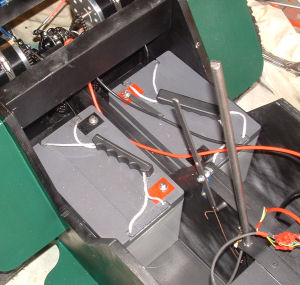 The
batteries are the weak points for many EV's – the
general problem faced by the vehicle designer is the
considerable volume or mass of battery needed to store
the amount of energy the vehicle will need to keep it
going between charges. Some battery technologies are
better at this than others i.e. some have higher “energy
densities” than others, and, yes you guessed it, the
cheaper battery types are generally the least capable.
Rechargeable lead acid batteries are the norm for most
DIY builds – they are easy to get, easy to charge and
are the least expensive to buy - as are their chargers.
They also come in a fair range of sizes (capacities)
which allows some flexibility in their packaging within
the vehicle. Other battery types that might be
considered are, for example, Ni-Cad, Ni-MH, Li-ion (and
others) although you will need to do your homework
before constructing powerful enough packs and make sure
you use compatible chargers. You can also expect to dig
deeper into your pockets. If you are interested in these
higher tech battery types check out the robot builders,
they are used by some to save weight in their robot
designs.
The
batteries are the weak points for many EV's – the
general problem faced by the vehicle designer is the
considerable volume or mass of battery needed to store
the amount of energy the vehicle will need to keep it
going between charges. Some battery technologies are
better at this than others i.e. some have higher “energy
densities” than others, and, yes you guessed it, the
cheaper battery types are generally the least capable.
Rechargeable lead acid batteries are the norm for most
DIY builds – they are easy to get, easy to charge and
are the least expensive to buy - as are their chargers.
They also come in a fair range of sizes (capacities)
which allows some flexibility in their packaging within
the vehicle. Other battery types that might be
considered are, for example, Ni-Cad, Ni-MH, Li-ion (and
others) although you will need to do your homework
before constructing powerful enough packs and make sure
you use compatible chargers. You can also expect to dig
deeper into your pockets. If you are interested in these
higher tech battery types check out the robot builders,
they are used by some to save weight in their robot
designs.
If going down the lead-acid route you will find a large
range available from shops supplying mobility scooters,
golf carts etc and plenty on-line. Be sure however to
use “cyclic” duty or “deep draw” types. These are
specifically made for vehicle applications and are
designed to be discharged deeply and then re-charged
over several hundred cycles. Their internal construction
is a bit different from standby or float type batteries
which generally do no see this cyclic duty. Conventional
automobile starter batteries are not cyclic duty
batteries.
 You'll find that some makes are more expensive than
others which may reflect the increased number of
charge/discharge cycles the battery can sustain before
it deteriorates and looses its ability to hold charge.
It is advisable to obtain the full spec sheets for the
batteries concerned to compare life, discharge currents,
charge currents etc. Mostly I use 12V batteries
connected to give 24 or 36Volt supplies. 17AmpH and
38AmphH are our most used sizes but there are bigger
units readily available up to about 75AmpH (in our
1300W yard tractor)
and heavier for larger vehicles.
You'll find that some makes are more expensive than
others which may reflect the increased number of
charge/discharge cycles the battery can sustain before
it deteriorates and looses its ability to hold charge.
It is advisable to obtain the full spec sheets for the
batteries concerned to compare life, discharge currents,
charge currents etc. Mostly I use 12V batteries
connected to give 24 or 36Volt supplies. 17AmpH and
38AmphH are our most used sizes but there are bigger
units readily available up to about 75AmpH (in our
1300W yard tractor)
and heavier for larger vehicles.
Proper
charging arrangements are important for prolonging
battery life. Get a multimode charger specifically
designed for deep cycle lead acid batteries. These will
have typically three modes of charge; a constant current
main charge, a constant voltage finishing charge and a
float top-up charge (at a lower constant voltage) to
keep the battery topped-up as long as it is connected to
the charger. These will not overcharge the battery and
can be left connected for long periods of time. 12V and
24V units are available with 12V being more common. Even
though you have a 24V pack you can still use a 12V
charger although it make require some connections to be
broken in the pack. For a good description of charging
options for battery packs check out Battery Tender's
article on connecting and charging battery packs
here.
Safety Note: Although the voltage in these battery packs
is relatively low the current that can flow in
short-circuit conditions can be enormous. The
unfortunate conductor (metal tool, misplaced cable etc
etc) that is causing the short circuit will get
extremely hot with potentially dangerous consequences.
Be very careful not to cause a short circuit across the
+ve & -ve terminals of either individual batteries or
the full pack.